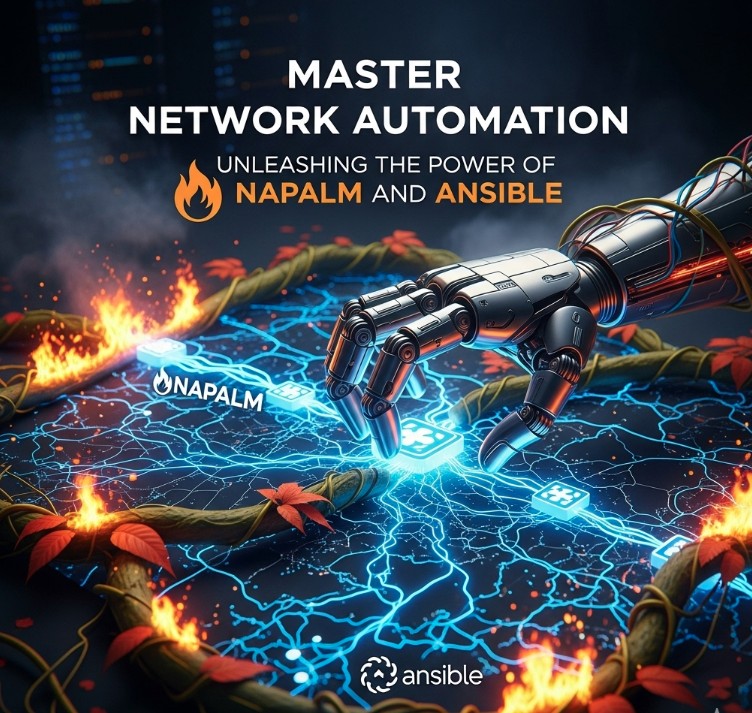In today’s dynamic IT landscape, manual network configuration is a relic of the past. The complexity and scale of modern networks demand automation for efficiency, consistency, and scalability. This article delves into the world of network automation, focusing on two powerful tools: NAPALM (Network Automation and Programmability Abstraction Layer with Multivendor support) and Ansible. We’ll explore how to leverage these tools to streamline your network management processes, reduce human error, and ultimately, improve operational efficiency. This guide will equip you with the knowledge and skills to implement robust network automation solutions.
Table of Contents
- 1 Understanding the Need for Network Automation
- 2 Introducing NAPALM: Simplifying Network Device Interaction
- 3 Ansible: Automating Network Configuration and Management
- 4 Integrating NAPALM and Ansible for Enhanced Network Automation
- 5 Network Automation Best Practices
- 6 Frequently Asked Questions
- 7 Conclusion
Understanding the Need for Network Automation
Traditional network management relies heavily on manual commands and configurations, a process prone to errors and inconsistencies. Scaling this approach across a large network becomes increasingly challenging and time-consuming. Network automation addresses these challenges by automating repetitive tasks, enabling efficient provisioning, and improving overall network management. The benefits extend to faster deployment, reduced operational costs, and improved network uptime.
- Reduced human error: Automation minimizes the risk of misconfigurations leading to outages or security vulnerabilities.
- Increased efficiency: Automating repetitive tasks frees up network engineers to focus on higher-level tasks.
- Improved scalability: Automation simplifies managing large and complex networks.
- Enhanced consistency: Automated configurations ensure consistent network behavior across all devices.
Introducing NAPALM: Simplifying Network Device Interaction
NAPALM is a Python library that provides a consistent API for interacting with various network devices, regardless of their vendor. This abstraction layer simplifies the process of retrieving and configuring network device parameters. Instead of learning vendor-specific CLI commands, you use a standardized NAPALM API, significantly reducing the learning curve and promoting code reusability.
Key NAPALM Features:
- Multi-vendor support: NAPALM supports a wide range of network devices from different vendors, including Cisco, Juniper, Arista, and more.
- Consistent API: Provides a unified interface for accessing network device information and performing configurations.
- Python-based: Leverages the power and versatility of the Python programming language.
- Open-source: Actively developed and maintained by the community, ensuring ongoing support and improvements.
Practical Example: Retrieving Interface Information with NAPALM
The following code snippet demonstrates how to use NAPALM to connect to a Cisco IOS device and retrieve interface information:
from napalm import get_network_driver
driver = get_network_driver('ios')
device = driver('192.168.1.100', 'username', 'password')
device.open()
interfaces = device.get_interfaces()
print(interfaces)
device.close()This example requires the installation of the NAPALM library: pip install napalm. Replace ‘192.168.1.100’, ‘username’, and ‘password’ with your device credentials.
Ansible: Automating Network Configuration and Management
Ansible is a powerful automation tool that simplifies the configuration and management of network devices. It uses a declarative approach, defining the desired state of the network, and Ansible ensures the network devices reach that state. Ansible’s agentless architecture simplifies deployment and management. It utilizes SSH to connect to devices, eliminating the need for agents on each network device.
Key Ansible Features for Network Automation:
- Agentless architecture: Simplifies deployment and reduces overhead.
- YAML configuration files: Provides a human-readable and easily manageable configuration format.
- Idempotency: Ensures that configurations are applied consistently, without causing unintended changes on repeated executions.
- Modules for network devices: Offers a rich set of modules specifically designed for managing network devices.
Ansible Playbook Example: Configuring Interface Description
This playbook utilizes the NAPALM Ansible module to configure the description of an interface on a network device:
---
- hosts: cisco_devices
connection: network_cli
gather_facts: false
tasks:
- name: Configure interface description
napalm_config:
commit: true
replace: false
config:
- interface: GigabitEthernet1/1
description: "Connection to Server Rack"This playbook requires the Ansible NAPALM module. You’ll need to define your cisco_devices inventory file appropriately.
Integrating NAPALM and Ansible for Enhanced Network Automation
Combining NAPALM and Ansible creates a powerful synergy for network automation. NAPALM provides the consistent API for interacting with diverse network devices, while Ansible handles the orchestration and automation of the configuration process. This combination allows for efficient and scalable network management.
Benefits of Integration:
- Increased efficiency: Automate complex tasks, significantly reducing manual effort.
- Improved consistency: Apply configurations consistently across multiple devices and vendors.
- Enhanced scalability: Easily manage large and complex networks with minimal effort.
- Reduced operational costs: Streamline network management processes, lowering operational expenses.
Network Automation Best Practices
Successful network automation requires careful planning and implementation. Consider these best practices:
- Modular design: Break down complex tasks into smaller, manageable modules.
- Version control: Use Git or similar tools to manage your Ansible playbooks and configurations.
- Testing: Thoroughly test your automation scripts in a controlled environment before deploying them to production.
- Error handling: Implement robust error handling to prevent issues and ensure smooth operation.
- Security: Secure your Ansible control server and network devices appropriately.
Frequently Asked Questions
Q1: What are the prerequisites for using NAPALM and Ansible for network automation?
A1: You’ll need Python installed for NAPALM and Ansible installed on your control server. You also require network device credentials (username and password) and SSH access to your network devices.
Q2: How do I choose the right network automation tools for my environment?
A2: The choice depends on your network size, complexity, and specific requirements. For smaller networks, simpler tools might suffice, while larger, more complex networks might benefit from more comprehensive solutions like Ansible and NAPALM combined. Evaluate your needs and choose accordingly.
Q3: What are some common challenges in implementing network automation?
A3: Common challenges include initial investment in learning the tools and developing automation scripts, managing access credentials securely, ensuring sufficient testing, and addressing potential compatibility issues between different network devices and versions.
Q4: Is network automation secure?
A4: Network automation, if implemented correctly, can enhance security by reducing human error and providing consistent configurations. However, proper security measures must be taken, including secure credential management, secure communication protocols (SSH), and regular security audits.

Conclusion
Network automation, using tools like NAPALM and Ansible, is crucial for modern network management. By embracing these technologies, organizations can significantly improve efficiency, reduce errors, and increase scalability. This article provided a foundation for understanding and implementing network automation. Remember to start small, focus on automating critical tasks, and always prioritize thorough testing before deploying to production. Mastering network automation requires ongoing learning and adaptation to new technologies and best practices.
Further reading: NAPALM Documentation, Ansible Documentation, Network to Code. Thank you for reading the DevopsRoles page!

